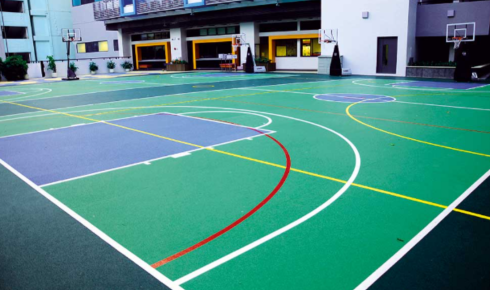India is witnessing a rapid transformation in sports infrastructure, with basketball gaining traction across schools, societies, sports clubs, and recreational spaces. With this shift comes the need for professional-quality courts that are safe, weather-resistant, and low-maintenance. This is where synthetic basketball courts, especially those made with acrylic materials, come into play. These courts not only improve game quality but also ensure long-term value for facility owners.
For a court to truly stand out, it requires more than just surfacing—it demands proper planning, quality materials, professional installation, and regular upkeep. From understanding basketball court size in meters to choosing the right basketball court color design, there’s a lot that goes into building a premium facility. Let’s explore what goes into constructing and maintaining the ideal outdoor basketball court using synthetic acrylic solutions.
Choosing the Right Basketball Court Makers
Finding experienced basketball court makers is the first step toward a successful project. These professionals offer the technical know-how and on-ground experience required to create courts that are not only durable but also meet international standards. From site assessment to finishing touches, seasoned makers understand the nuances of slope correction, drainage, and sub-base preparation, especially for synthetic acrylic courts.
A credible court maker will offer tailored advice on the best surfacing system for your location. In India’s diverse climate, acrylic-based courts are ideal due to their UV resistance and ability to endure both dry heat and monsoon rains. Builders who specialize in these systems ensure proper layering, curing, and adherence to specifications—preventing cracks and surface failures in the long run.
Benefits of Synthetic Acrylic Basketball Courts
A synthetic basketball court made with acrylic materials offers numerous advantages over traditional concrete or asphalt surfaces. Acrylic coatings are designed for performance—they offer high surface grip, excellent ball bounce, and player comfort. These benefits are crucial for player safety, especially in outdoor environments where moisture or dust can otherwise cause slips and injuries.
One of the standout features of synthetic acrylic surfaces is their durability. Once applied in multiple layers over a concrete or asphalt base, these coatings form a seamless and weatherproof top layer. This makes them ideal for outdoor installations, as they withstand UV radiation, rain, and temperature fluctuations without losing color or surface integrity.
Acrylic courts are also easier to maintain and refresh through synthetic basketball court resurfacing. Instead of complete replacement, courts can be renewed by reapplying acrylic layers, restoring aesthetics and performance at a fraction of the cost. This sustainable approach makes acrylic flooring systems a long-term winner for schools, clubs, and sports infrastructure developers.
Outdoor Basketball Court Flooring: What You Need to Know
When it comes to outdoor basketball court flooring, choosing the right material makes all the difference. Acrylic surfaces are known for their textured finish, which enhances traction even in wet conditions. This is particularly valuable in Indian cities where outdoor play is common and courts need to be ready for action throughout the year.
Acrylic flooring systems are applied in layers, including a cushion layer (optional), color coatings, and textured top finishes. Each layer serves a specific purpose, from shock absorption to color retention and slip resistance. This engineered layering ensures a smooth, durable, and performance-focused surface ideal for high-frequency usage.
Apart from functionality, synthetic acrylic courts are highly customizable. Clients can choose from a wide range of basketball court color design options, enabling branding or school-themed courts. With superior UV-stable pigments, the colors remain vibrant for years, adding a professional look to your basketball facility.
Understanding Basketball Court Size, Layout, and Measurement
The standard basketball court size in meters, as per FIBA regulations, is 28 meters in length and 15 meters in width. These dimensions are critical for ensuring uniform gameplay and fair player development. Professional basketball court makers always follow these guidelines, whether for a full-sized match court or a scaled-down practice court.
The basketball court layout includes important components such as the free-throw circle, the three-point arc, and the key (painted area). Proper marking and spacing ensure that players can practice drills accurately and adapt to competitive standards. Using acrylic line-marking paint ensures long-lasting visibility that resists fading, even under harsh sunlight.
In addition to the main playing area, accurate basketball court measurement includes correct line widths (usually 5 cm), hoop height (3.05 m), and backboard size. Misalignment or incorrect markings can affect player performance and game dynamics. That’s why precision and adherence to international norms are crucial during the installation phase.
Basketball Court Construction with Synthetic Acrylic Systems
The basketball court construction process using acrylic systems begins with base preparation. This includes soil compaction, drainage planning, and laying a stable sub-base like asphalt or concrete. A smooth, leveled base is critical for the subsequent application of synthetic layers.
Once the base is ready, the acrylic coating is applied in stages. This may include a primer coat, cushion layer (if required), color coats, and the textured final layer. Each coat is allowed to dry properly before the next one is applied. This multi-layered approach ensures long-term adhesion and performance, making the surface ideal for rigorous gameplay.
After surfacing, the final touches include basketball court layout line marking, hoop installation, and optionally fencing or lighting. The entire construction timeline usually spans 3–4 weeks, depending on size and weather conditions. A professionally constructed court guarantees consistent gameplay and minimal maintenance requirements.
Maintaining and Resurfacing Synthetic Basketball Courts
Ongoing basketball court maintenance is essential to preserve play quality and aesthetics. Regular sweeping, washing, and inspecting the surface for any cracks or fading can prevent bigger issues. Acrylic courts are low-maintenance but benefit from periodic checks, especially after monsoon or heavy usage events.
Over time, even the best surfaces start to show signs of wear. Synthetic basketball court resurfacing involves cleaning the surface, repairing any minor damage, and applying fresh layers of acrylic coating. This process renews the look and feel of the court without the need for a full rebuild.
Resurfacing also allows for updating the basketball court color design or changing the layout slightly for newer formats. Done every 4–6 years, resurfacing keeps the court vibrant, safe, and ready for competitive action, ensuring you continue to get the most out of your investment.
Basketball Court Installation Best Practices
Proper basketball court installation ensures not just surface quality but also longevity and safety. Professional installers start with weatherproofing the base, followed by accurate application of acrylic layers. Careful attention is paid to temperature, humidity, and curing time between coats.
Experts also account for slope to prevent water stagnation—one of the leading causes of surface damage in outdoor courts. They also ensure that basketball court measurement and layout markings are compliant with regulations and aligned with gameplay standards.
Finally, after installation, clients are provided with maintenance guidelines and schedules. Reliable basketball court makers offer post-installation support, training for staff, and warranties to ensure peace of mind and maximum court performance.
Conclusion
Investing in a well-designed synthetic basketball court with acrylic surfacing ensures long-term value, durability, and player satisfaction. With professional basketball court makers, accurate measurements, resilient outdoor basketball court flooring, and a solid maintenance strategy, your court becomes a center for high-quality sport and community engagement.
Whether you’re planning a court for a school, society, or sports academy, acrylic-based systems offer the best blend of aesthetics, safety, and performance. Reach out to certified experts and transform your vision into a lasting legacy for players and spectators alike.




